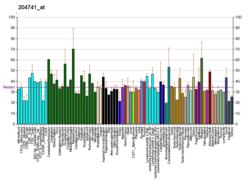BICD1
Protein bicaudal D homolog 1 is a protein that in humans is encoded by the BICD1 gene.[5][6]
Function
This gene is one of two human homologs of Drosophila bicaudal-D. It has been implicated in COPI-independent membrane transport from the Golgi apparatus to the endoplasmic reticulum. Two alternative splice variants have been described. Other alternative splice variants that encode different protein isoforms have been described but their full-length nature has not been determined.[6]
Interactions
BICD1 has been shown to interact with RAB6A.[7][8]
gollark: Wait a minute. Different capitalizations of rUST can encode base 16 data!
gollark: trust in rust
gollark: Rtryuuuusturuyyryysyt.
gollark: Add <@509849474647064576> or else.
gollark: GNU/Monads also have to be applicatives and functors.
References
- GRCh38: Ensembl release 89: ENSG00000151746 - Ensembl, May 2017
- GRCm38: Ensembl release 89: ENSMUSG00000003452 - Ensembl, May 2017
- "Human PubMed Reference:". National Center for Biotechnology Information, U.S. National Library of Medicine.
- "Mouse PubMed Reference:". National Center for Biotechnology Information, U.S. National Library of Medicine.
- Baens M, Marynen P (Nov 1997). "A human homologue (BICD1) of the Drosophila bicaudal-D gene". Genomics. 45 (3): 601–6. doi:10.1006/geno.1997.4971. PMID 9367685.
- "Entrez Gene: BICD1 bicaudal D homolog 1 (Drosophila)".
- Short B, Preisinger C, Schaletzky J, Kopajtich R, Barr FA (Oct 2002). "The Rab6 GTPase regulates recruitment of the dynactin complex to Golgi membranes". Current Biology. 12 (20): 1792–5. doi:10.1016/S0960-9822(02)01221-6. PMID 12401177.
- Matanis T, Akhmanova A, Wulf P, Del Nery E, Weide T, Stepanova T, Galjart N, Grosveld F, Goud B, De Zeeuw CI, Barnekow A, Hoogenraad CC (Dec 2002). "Bicaudal-D regulates COPI-independent Golgi-ER transport by recruiting the dynein-dynactin motor complex". Nature Cell Biology. 4 (12): 986–92. doi:10.1038/ncb891. PMID 12447383.
External links
- Human BICD1 genome location and BICD1 gene details page in the UCSC Genome Browser.
Further reading
- Barr FA, Short B (Aug 2003). "Golgins in the structure and dynamics of the Golgi apparatus". Current Opinion in Cell Biology. 15 (4): 405–13. doi:10.1016/S0955-0674(03)00054-1. PMID 12892780. Check date values in:
|year= / |date= mismatch(help) - Claussen M, Suter B (Nov 2005). "BicD-dependent localization processes: from Drosophilia development to human cell biology". Annals of Anatomy - Anatomischer Anzeiger. 187 (5–6): 539–53. doi:10.1016/j.aanat.2005.07.004. PMID 16320833. Check date values in:
|year= / |date= mismatch(help) - Baens M, Aerssens J, van Zand K, Van den Berghe H, Marynen P (Sep 1995). "Isolation and regional assignment of human chromosome 12p cDNAs". Genomics. 29 (1): 44–52. doi:10.1006/geno.1995.1213. PMID 8530100. Check date values in:
|year= / |date= mismatch(help) - Short B, Preisinger C, Schaletzky J, Kopajtich R, Barr FA (Oct 2002). "The Rab6 GTPase regulates recruitment of the dynactin complex to Golgi membranes". Current Biology. 12 (20): 1792–5. doi:10.1016/S0960-9822(02)01221-6. PMID 12401177. Check date values in:
|year= / |date= mismatch(help) - Matanis T, Akhmanova A, Wulf P, Del Nery E, Weide T, Stepanova T, Galjart N, Grosveld F, Goud B, De Zeeuw CI, Barnekow A, Hoogenraad CC (Dec 2002). "Bicaudal-D regulates COPI-independent Golgi-ER transport by recruiting the dynein-dynactin motor complex". Nature Cell Biology. 4 (12): 986–92. doi:10.1038/ncb891. PMID 12447383. Check date values in:
|year= / |date= mismatch(help) - Tomsig JL, Snyder SL, Creutz CE (Mar 2003). "Identification of targets for calcium signaling through the copine family of proteins. Characterization of a coiled-coil copine-binding motif". The Journal of Biological Chemistry. 278 (12): 10048–54. doi:10.1074/jbc.M212632200. PMID 12522145.
- Kimura K, Wakamatsu A, Suzuki Y, Ota T, Nishikawa T, Yamashita R, Yamamoto J, Sekine M, Tsuritani K, Wakaguri H, Ishii S, Sugiyama T, Saito K, Isono Y, Irie R, Kushida N, Yoneyama T, Otsuka R, Kanda K, Yokoi T, Kondo H, Wagatsuma M, Murakawa K, Ishida S, Ishibashi T, Takahashi-Fujii A, Tanase T, Nagai K, Kikuchi H, Nakai K, Isogai T, Sugano S (Jan 2006). "Diversification of transcriptional modulation: large-scale identification and characterization of putative alternative promoters of human genes". Genome Research. 16 (1): 55–65. doi:10.1101/gr.4039406. PMC 1356129. PMID 16344560.
- Fuchs E, Short B, Barr FA (2006). "Assay and properties of rab6 interaction with dynein-dynactin complexes". Methods in Enzymology. 403: 607–18. doi:10.1016/S0076-6879(05)03053-3. PMID 16473624.
- Moorhead AR, Rzomp KA, Scidmore MA (Feb 2007). "The Rab6 effector Bicaudal D1 associates with Chlamydia trachomatis inclusions in a biovar-specific manner". Infection and Immunity. 75 (2): 781–91. doi:10.1128/IAI.01447-06. PMC 1828475. PMID 17101644.
- Fumoto K, Hoogenraad CC, Kikuchi A (Dec 2006). "GSK-3beta-regulated interaction of BICD with dynein is involved in microtubule anchorage at centrosome". The EMBO Journal. 25 (24): 5670–82. doi:10.1038/sj.emboj.7601459. PMC 1698904. PMID 17139249. Check date values in:
|year= / |date= mismatch(help) - Wanschers BF, van de Vorstenbosch R, Schlager MA, Splinter D, Akhmanova A, Hoogenraad CC, Wieringa B, Fransen JA (Oct 2007). "A role for the Rab6B Bicaudal-D1 interaction in retrograde transport in neuronal cells". Experimental Cell Research. 313 (16): 3408–20. doi:10.1016/j.yexcr.2007.05.032. PMID 17707369.
This article is issued from Wikipedia. The text is licensed under Creative Commons - Attribution - Sharealike. Additional terms may apply for the media files.




